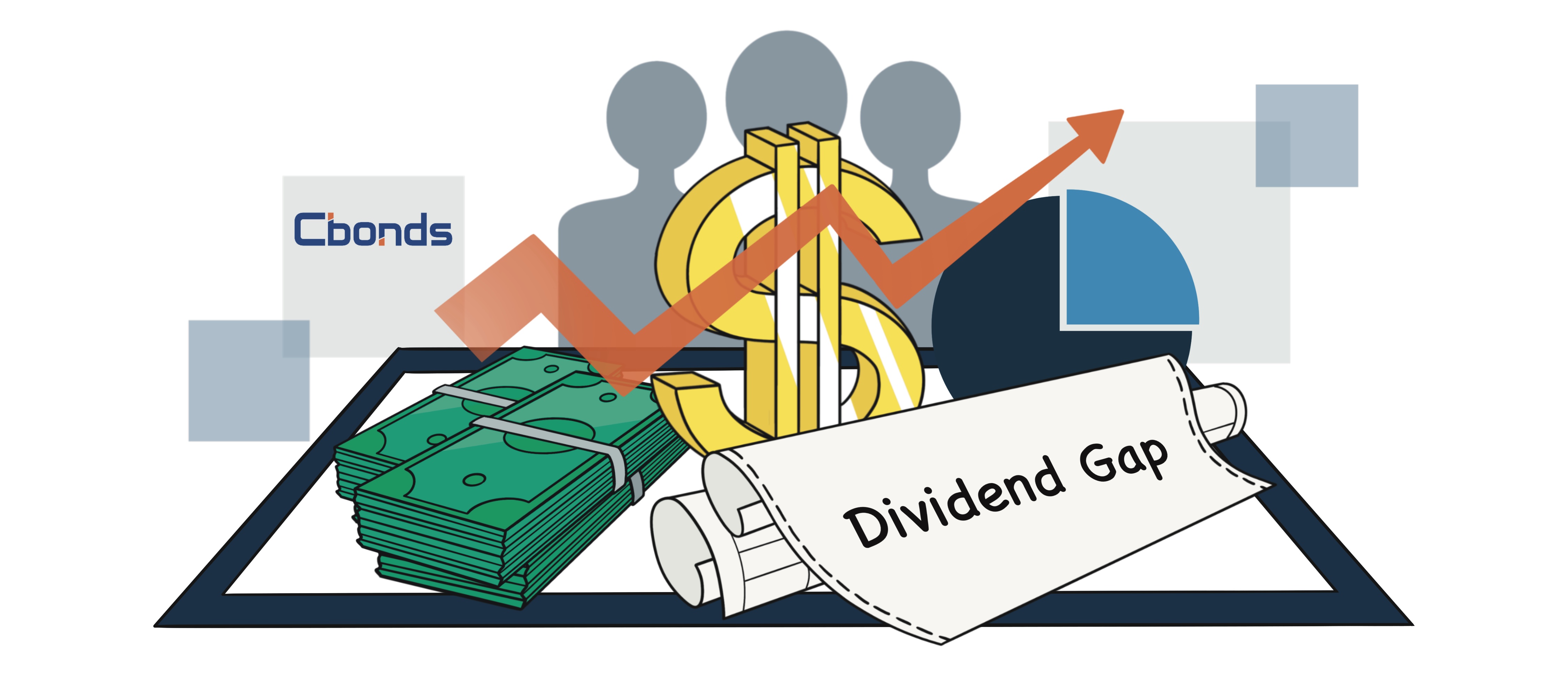By
Konstantin Vasilev Member of the Board of Directors of Cbonds, Ph.D. in Economics
Updated October 23, 2023
What Does Dividend Gap Mean?
Dividend gap refers to the decrease in the price of a share on the trading day immediately following the ex-dividend date, which typically doesn’t exceed the declared value of the dividend per share. This reduction is a result of the company paying out dividends to its shareholders.
Causes of Dividend Gaps
The Dividend gap is primarily caused by the interplay of several factors related to dividend payouts and investor behavior. Here’s a breakdown of these causes:
The process typically begins when a company’s Board of Directors decides to declare a dividend. This decision sets in motion a series of events leading to the dividend gap.
Once news about the company’s intention to pay dividends becomes public, investors rush to buy the company’s shares. This heightened demand for the stock is driven by the desire to be included in the company’s register of shareholders and, consequently, to receive dividends.
The surge in investor interest translates into an increase in the stock’s price. In the example of John B. Sanfilippo & Son, their share price rose significantly, from $78 to $93, representing a 19% increase. This upward price movement contrasts sharply with the average annual dividend yield in the US, which typically hovers around 2%.
Savvy and experienced investors often employ a strategic approach. They start purchasing shares well in advance of the dividend payout announcement. Their investment decisions are based on careful analysis of the company’s financial statements, its historical dividend policy, and the stability of its dividend payments.
These experienced investors aim to become registered shareholders before the ex-dividend date. By achieving this, they position themselves to receive the upcoming dividend payment. However, their intention is not just to collect dividends; they also aim to capitalize on the positive price movement of the stock that typically occurs before the ex-dividend date.

How to Avoid Losing Money on the Gap
-
Long-Term Investment After Dividend Gap. Investors opt to purchase shares after the dividend gap occurs, intending to hold onto these shares for an extended period. Initially, the share price may experience a decline as a result of the dividend payout. However, the investor anticipates that the dividends they receive will compensate for the short-term loss. In the foreseeable future, the share price is expected to recover. This approach is contingent on choosing the right company with promising shares. The key here is patience and a long-term perspective. By investing in companies with growth potential, investors can recover any temporary losses through dividends and capital appreciation over time.
-
Dividend Recapitalization. Some investors acquire assets as long-term investments with the primary aim of receiving dividends. Once dividends are received, investors can choose to reinvest these earnings by purchasing additional shares of the same company or even different companies. This strategy allows for the compounding of wealth over time, as reinvested dividends can lead to a larger equity stake and potentially higher future returns.
How to Make Money on the Gap
-
Investors purchase shares well before the ex-dividend date and secure a spot on the list of shareholders eligible to receive dividends. Following the closure of the register, the share price typically experiences a drop. However, the investor continues to hold the shares, waiting for their value to rise to a satisfactory level. The key advantage of this strategy is the assurance of a consistent income. In most cases, the dividend gap closes within a year, and sometimes even within a few weeks or days. In the United States, dividend gaps are often modest, and share prices tend to return to their original levels relatively quickly.
-
Investors opt to purchase shares on the ex-dividend date. At this point, share prices are lower compared to the previous day by the amount of the dividend paid. Once the share price rebounds and returns to its pre-dividend gap level, the investor sells the shares. This approach aims to profit from the price differential.
-
Investors buy shares just before the dividend gap is set to occur. The expectation is that the share price will increase and eventually close the gap. This strategy relies on the high likelihood of share prices rising, which can lead to a good yield for the investor.
-
Investors target shares of companies with a track record of increased profitability. Dividends received from these shares are reinvested in the purchase of the same or similar securities at a low cost during the gap period. These reinvested shares have the potential to generate profits as their prices recover.
Actions to Refrain from During the Gap Period
During the Gap period, there are certain actions that investors should avoid, especially if they are relatively inexperienced in the stock market. Novice investors might be tempted to try and profit from the rise in share prices before the closure of the shareholder register, followed by a sharp decline. However, this strategy can be riddled with pitfalls.
Short selling, which involves borrowing shares from a broker before the ex-dividend date and selling them at a higher price, is a complex and high-risk approach. It can lead to substantial losses if not executed with a clear understanding of market dynamics.
It’s important to note that short selling requires in-depth analysis and a strong grasp of market trends. It’s a strategy best suited for experienced investors who are well-versed in the intricacies of the stock market.
Additionally, short selling is not without risks, and investors should be cautious and thoroughly evaluate the potential downsides before engaging in such trading practices.
Bond Screener
Watchlist
Excel add-in
API














